AUDI Q5 2014 8R / 1.G Getting To Know
Manufacturer: AUDI, Model Year: 2014, Model line: Q5, Model: AUDI Q5 2014 8R / 1.GPages: 29, PDF Size: 6.93 MB
Page 21 of 29

Downloaded from www.Manualslib.com manuals search engine Optional Panoramic SunroofOpen Turn the dial clockwise to any of the differently sized rectangles. To open the sunroof completely, twist the dial clockwise, as far as it will go and hold.Comfort PositionOpening the sunroof to the Comfort position will help minimize variations in cabin pressure and wind noise. To open to the Comfort position, simply turn the dial to the last dark rectangle. Wh
en the sunroof opens, the wind screen will automatically rise. This will help
reduce wind noise.
TEXT Q5ROOF to 38981Do not text and drive. Message and data rates may apply.
35
CloseTurn the dial counterclockwise to the closed position.TiltFor the sunroof to tilt up, gently press up on the lip of the sunroof
dial.
To tilt down, pull down on the dial lip.SunshadeTo move the sunshade forward or back, use the respective arrow buttons. One
touch of the button opens or closes the sunshade all the way.
To s
top the sunshade while it is moving, press the button again.
Important Safety Instructions and Warnings which you must read, are listed on the last panel under Sunroof.
36
Sunroof
Page 22 of 29
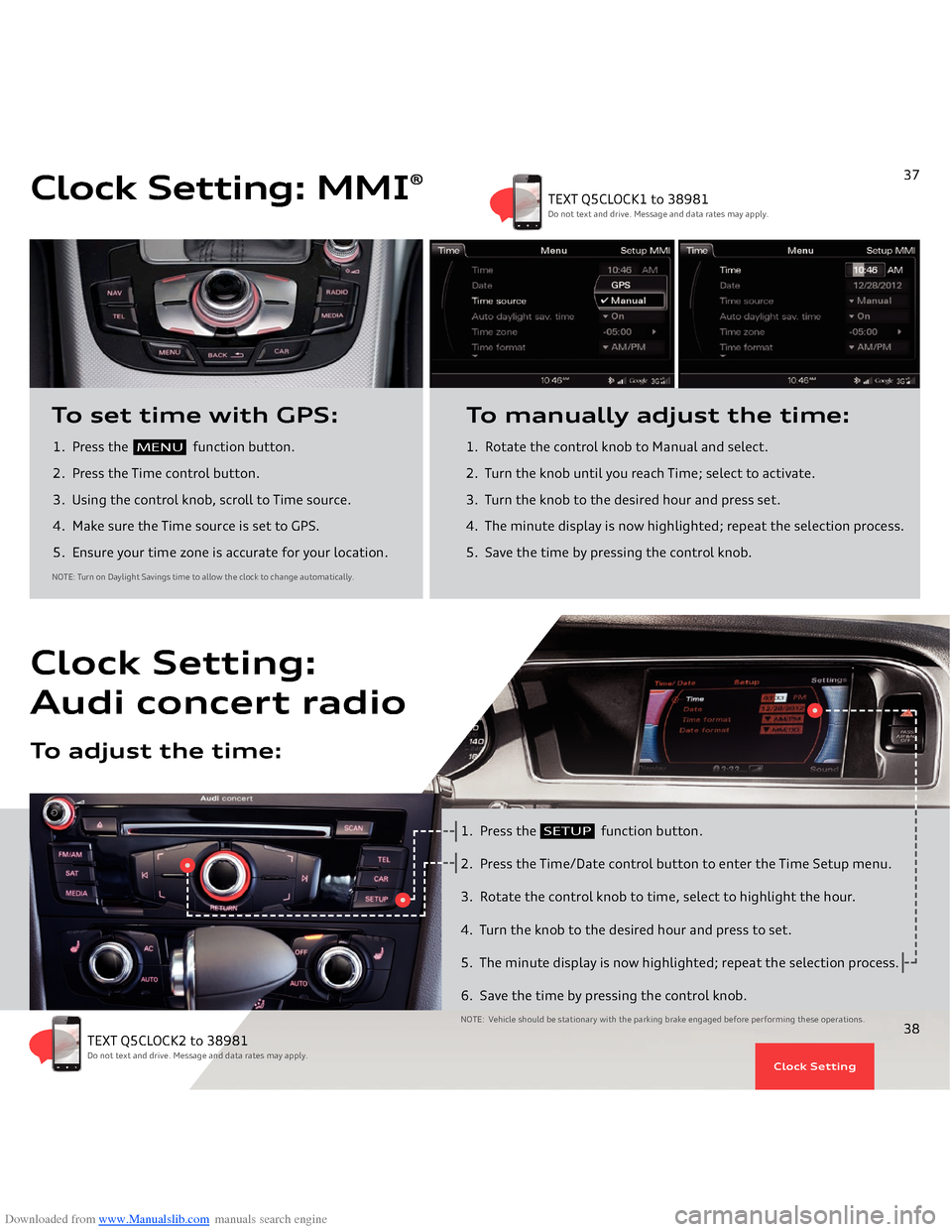
Downloaded from www.Manualslib.com manuals search engine 1. Press the
function button.
2. Press the Time control button.
3. Using the control knob, scroll to Time source. 4. Make sure the Time source is set to GPS.5. Ensure your time zone is accurate for your location.To set time with GPS:
1. Rotate the control knob to Manual and select.
2. Turn the knob until you reach Time; select to activate.3. Turn the knob to the desired hour and press set.4. The minute display is now highlighted; repeat the selection process.5. Save the time by pressing the control knob.To manually adjust the time:
NOTE: Turn on Daylight Savings time to allow the clock to change automatically.
Clock Setting: MMI
®
MENU
37
TEXT Q5CLOCK1 to 38981Do not text and drive. Message and data rates may apply.
Clock Setting
1. Press the
function button.
2. Press the Time/Date control button to enter the Time Setup menu.3. Rotate the control knob to time, select to highlight the hour.4. Turn the knob to the desired hour and press to set.5. The minute display is now highlighted; repeat the selection process.6. Save the time by pressing the control knob.NOTE: Vehicle should be stationary with the parking brake engaged before performing these operations.
Clock Setting:Audi concert radi
o
To adjust the time:
SETUP
38
TEXT Q5CLOCK2 to 38981Do not text and drive. Message and data rates may apply.
Clock Setting
Page 23 of 29

Downloaded from www.Manualslib.com manuals search engine • The rear hatch can be opened and closed automatically. There are three ways to open the power rear hatch.Open the Hatch
Important Safety Instructions and Warnings which you must read, are listed on the last panel under Rear Hatch.
NOTE: Photo may not represent actual vehicle.
TEXT Q5HATCH to 38981Do not text and drive. Message and data rates may apply.
39
Optional Power Rear Hatch
• Press and hold the rear hatch
button on the key fob for at
least one second.
• Pull the switch on the
driver’s door.
• Press the micro-switch
located above the license plate.
Option 1
Option 2
Option 3
Rear Hatch
40
Page 24 of 29
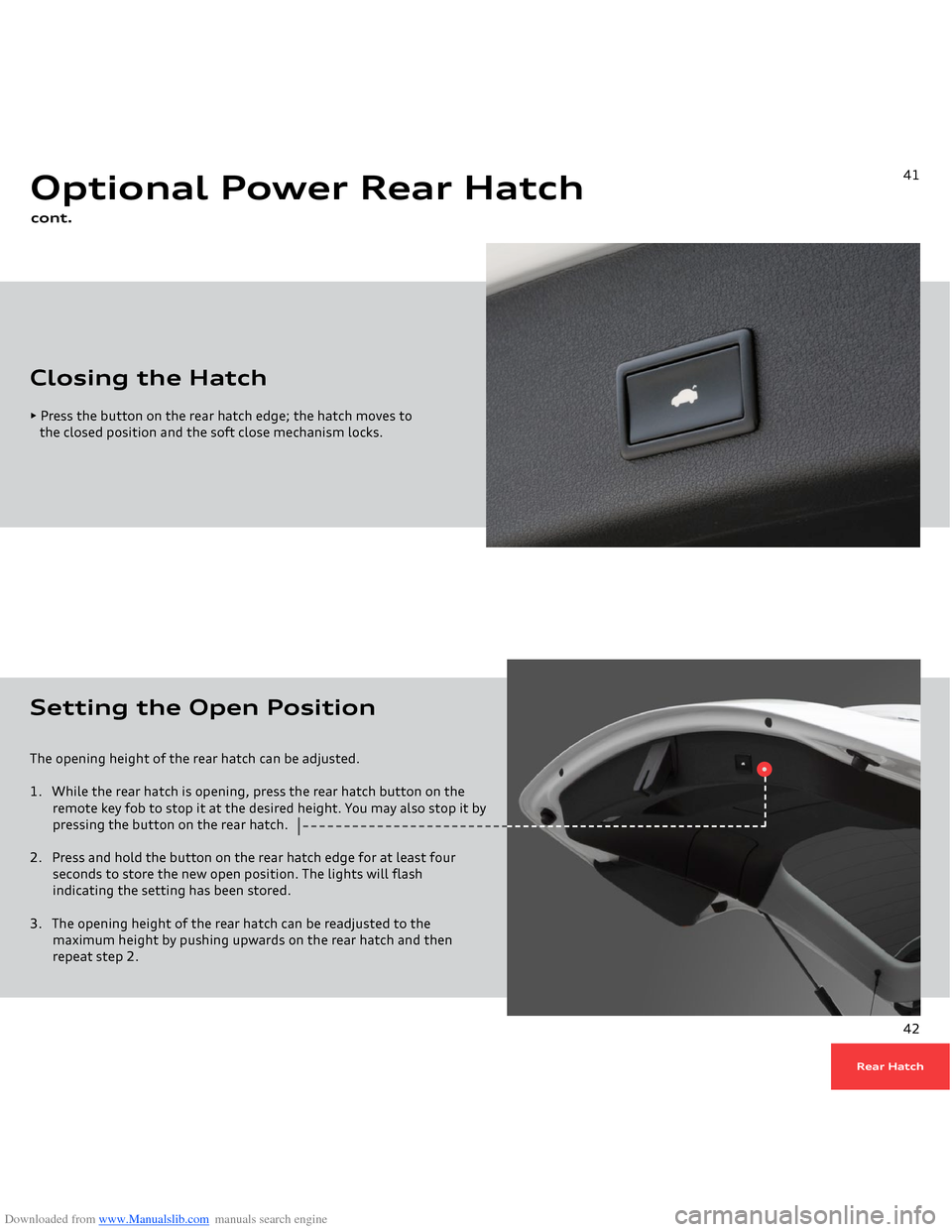
Downloaded from www.Manualslib.com manuals search engine Closing the Hatch • Press the button on the rear hatch edge; the hatch moves to
the closed position and the soft close mechanism locks. Optional Power Rear Hatchcont.
41
Setting the Open PositionThe opening height of the rear hatch can be adjusted.
1. While the rear hatch is opening, press the rear hatch button on the
remote key fob to stop it at the desired height. You may also stop it by pressing the button on the rear hatch.2. Press and hold the button on the rear hatch edge for at least four
seconds to store the new open position. The lights will flash indicating the setting has been stored.3. The opening height of the rear hatch can be readjusted to the maximum height by pushing upwards on the rear hatch and then repeat step 2.
Rear Hatch
42
Page 25 of 29
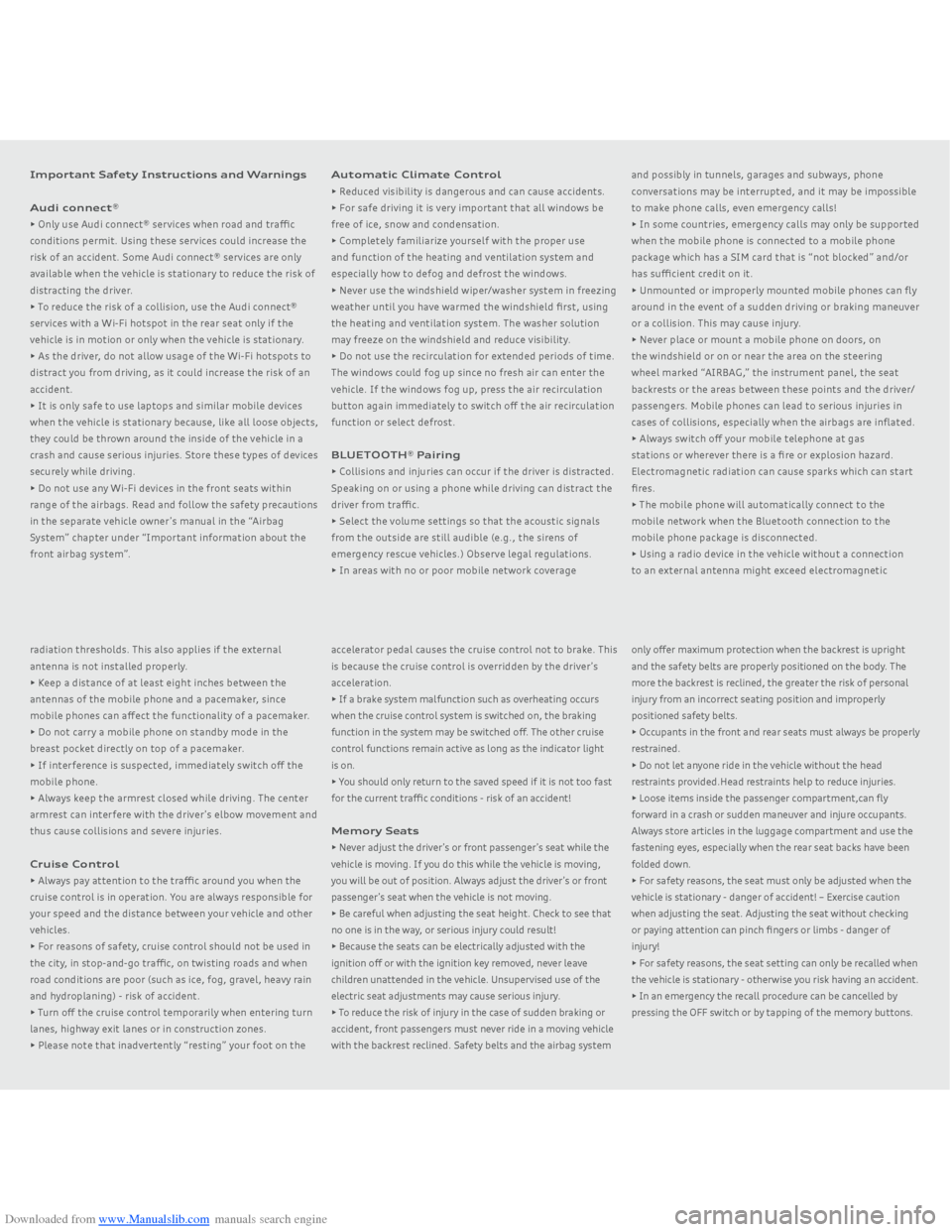
Downloaded from www.Manualslib.com manuals search engine Important Safety Instructions and WarningsAudi connect
®
• Only use Audi connect® services when road and traffic conditions permit. Using these services could increase the risk of an accident. Some Audi connect® services are only available when the vehicle is stationary to reduce the risk of distracting the driver.• To reduce the risk of a collision, use the Audi connect® services with a Wi-Fi hotspot in the rear seat only if the vehicle is in motion or only when the vehicle is stationary.• As the driver, do not allow usage of the Wi-Fi hotspots to distract you from driving, as it could increase the risk of an accident.• It is only safe to use laptops and similar mobile devices when the vehicle is stationary because, like all loose objects, they could be thrown around the inside of the vehicle in a crash and cause serious injuries. Store these types of devices securely while driving.• Do not use any Wi-Fi devices in the front seats within range of the airbags. Read and follow the safety precautions in the separate vehicle owner’s manual in the “Airbag System” chapter under “Important information about the front airbag system”.
Automatic Climate Control• Reduced visibility is dangerous and can cause accidents.• For safe driving it is very important that all windows be free of ice, snow and condensation.• Completely familiarize yourself with the proper use and function of the heating and ventilation system and especially how to defog and defrost the windows.• Never use the windshield wiper/washer system in freezing weather until you have warmed the windshield first, using the heating and ventilation system. The washer solution may freeze on the windshield and reduce visibility.• Do not use the recirculation for extended periods of time. The windows could fog up since no fresh air can enter the vehicle. If the windows fog up, press the air recirculation button again immediately to switch off the air recirculation function or select defrost.BLUETOOTH
® Pairing
• Collisions and injuries can occur if the driver is distracted. Speaking on or using a phone while driving can distract the driver from traffic.• Select the volume settings so that the acoustic signals from the outside are still audible (e.g., the sirens of emergency rescue vehicles.) Observe legal regulations.• In areas with no or poor mobile network coverage
and possibly in tunnels, garages and subways, phone conversations may be interrupted, and it may be impossible to make phone calls, even emergency calls!• In some countries, emergency calls may only be supported when the mobile phone is connected to a mobile phone package which has a SIM card that is “not blocked” and/or has sufficient credit on it.• Unmounted or improperly mounted mobile phones can fly around in the event of a sudden driving or braking maneuver or a collision. This may cause injury.• Never place or mount a mobile phone on doors, on the windshield or on or near the area on the steering wheel marked “AIRBAG,” the instrument panel, the seat backrests or the areas between these points and the driver/passengers. Mobile phones can lead to serious injuries in cases of collisions, especially when the airbags are inflated.• Always switch off your mobile telephone at gas stations or wherever there is a fire or explosion hazard. Electromagnetic radiation can cause sparks which can start fires.• The mobile phone will automatically connect to the mobile network when the Bluetooth connection to the mobile phone package is disconnected.• Using a radio device in the vehicle without a connection to an external antenna might exceed electromagnetic
radiation thresholds. This also applies if the external antenna is not installed properly.• Keep a distance of at least eight inches between the antennas of the mobile phone and a pacemaker, since mobile phones can affect the functionality of a pacemaker.• Do not carry a mobile phone on standby mode in the breast pocket directly on top of a pacemaker.• If interference is suspected, immediately switch off the mobile phone.• Always keep the armrest closed while driving. The center armrest can interfere with the driver’s elbow movement and thus cause collisions and severe injuries.Cruise Control
• Always pay attention to the traffic around you when the cruise control is in operation. You are always responsible for your speed and the distance between your vehicle and other vehicles.• For reasons of safety, cruise control should not be used in the city, in stop-and-go traffic, on twisting roads and when road conditions are poor (such as ice, fog, gravel, heavy rain and hydroplaning) - risk of accident.• Turn off the cruise control temporarily when entering turn lanes, highway exit lanes or in construction zones.• Please note that inadvertently “resting” your foot on the
accelerator pedal causes the cruise control not to brake. This is because the cruise control is overridden by the driver’s acceleration.• If a brake system malfunction such as overheating occurs when the cruise control system is switched on, the braking function in the system may be switched off. The other cruise control functions remain active as long as the indicator light is on.• You should only return to the saved speed if it is not too fast for the current traffic conditions - risk of an accident!Memory Seats• Never adjust the driver’s or front passenger’s seat while the vehicle is moving. If you do this while the vehicle is moving, you will be out of position. Always adjust the driver’s or front passenger’s seat when the vehicle is not moving.• Be careful when adjusting the seat height. Check to see that no one is in the way, or serious injury could result!• Because the seats can be electrically adjusted with the ignition off or with the ignition key removed, never leave children unattended in the vehicle. Unsupervised use of the electric seat adjustments may cause serious injury.• To reduce the risk of injury in the case of sudden braking or accident, front passengers must never ride in a moving vehicle with the backrest reclined. Safety belts and the airbag system
only offer maximum protection when the backrest is upright and the safety belts are properly positioned on the body. The more the backrest is reclined, the greater the risk of personal injury from an incorrect seating position and improperly positioned safety belts.• Occupants in the front and rear seats must always be properly restrained.• Do not let anyone ride in the vehicle without the head restraints provided.Head restraints help to reduce injuries.• Loose items inside the passenger compartment,can fly forward in a crash or sudden maneuver and injure occupants.Always store articles in the luggage compartment and use the fastening eyes, especially when the rear seat backs have been folded down.• For safety reasons, the seat must only be adjusted when the vehicle is stationary - danger of accident! – Exercise caution when adjusting the seat. Adjusting the seat without checking or paying attention can pinch fingers or limbs - danger of injury!• For safety reasons, the seat setting can only be recalled when the vehicle is stationary - otherwise you risk having an accident.• In an emergency the recall procedure can be cancelled by pressing the OFF switch or by tapping of the memory buttons.
Page 26 of 29
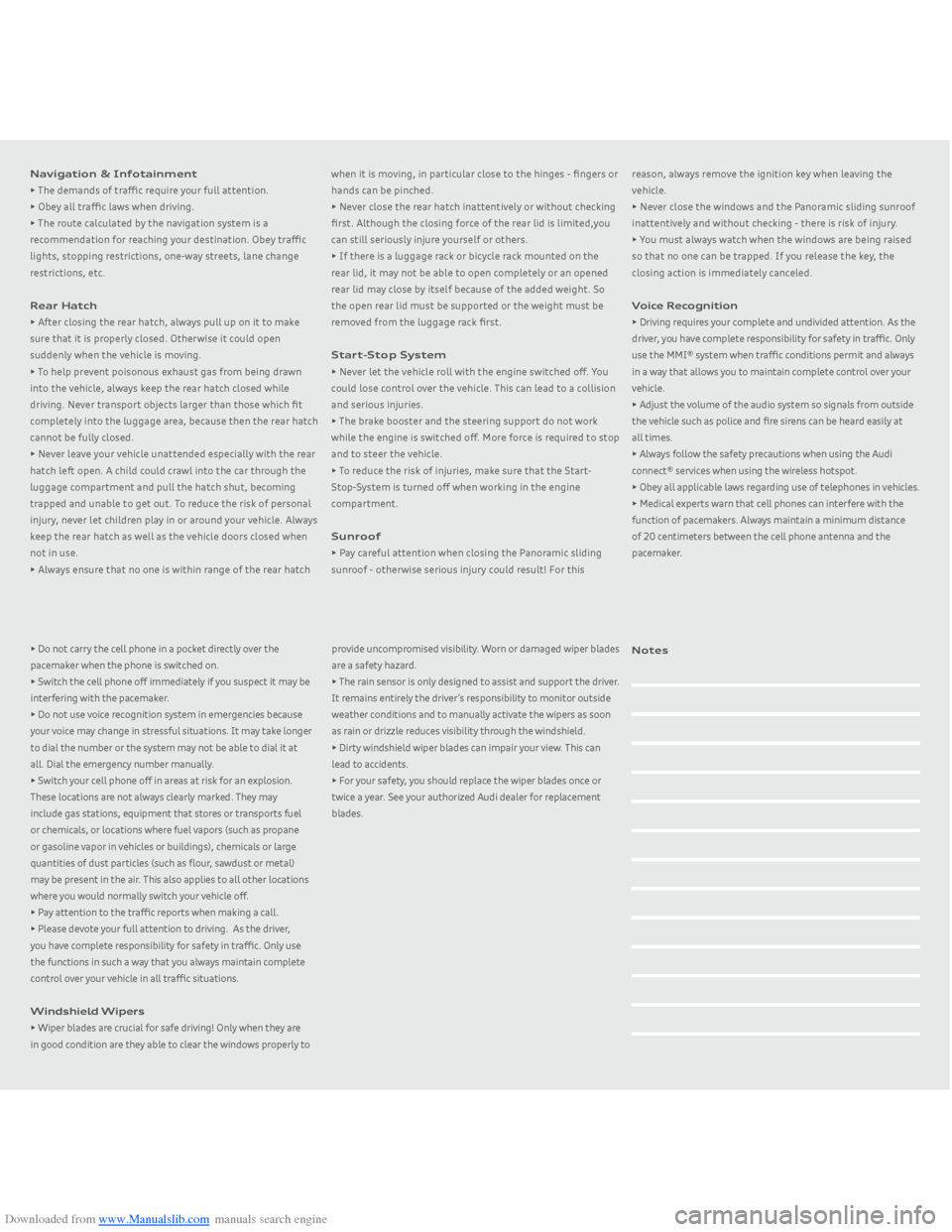
Downloaded from www.Manualslib.com manuals search engine Navigation & Infotainment
• The demands of traffic require your full attention.• Obey all traffic laws when driving.• The route calculated by the navigation system is a recommendation for reaching your destination. Obey traffic lights, stopping restrictions, one-way streets, lane change restrictions, etc.Rear Hatch• After closing the rear hatch, always pull up on it to make sure that it is properly closed. Otherwise it could open suddenly when the vehicle is moving.• To help prevent poisonous exhaust gas from being drawn into the vehicle, always keep the rear hatch closed while driving. Never transport objects larger than those which fit completely into the luggage area, because then the rear hatch cannot be fully closed.• Never leave your vehicle unattended especially with the rear hatch left open. A child could crawl into the car through the luggage compartment and pull the hatch shut, becoming trapped and unable to get out. To reduce the risk of personal injury, never let children play in or around your vehicle. Always keep the rear hatch as well as the vehicle doors closed when not in use.• Always ensure that no one is within range of the rear hatch
when it is moving, in particular close to the hinges - fingers or hands can be pinched.• Never close the rear hatch inattentively or without checking first. Although the closing force of the rear lid is limited,you can still seriously injure yourself or others.• If there is a luggage rack or bicycle rack mounted on the rear lid, it may not be able to open completely or an opened rear lid may close by itself because of the added weight. So the open rear lid must be supported or the weight must be removed from the luggage rack first.Start-Stop System• Never let the vehicle roll with the engine switched off. You could lose control over the vehicle. This can lead to a collision and serious injuries.• The brake booster and the steering support do not work while the engine is switched off. More force is required to stop and to steer the vehicle.• To reduce the risk of injuries, make sure that the Start-Stop-System is turned off when working in the engine compartment.Sunroof• Pay careful attention when closing the Panoramic sliding sunroof - otherwise serious injury could result! For this
reason, always remove the ignition key when leaving the vehicle.• Never close the windows and the Panoramic sliding sunroof inattentively and without checking - there is risk of injury.• You must always watch when the windows are being raised so that no one can be trapped. If you release the key, the closing action is immediately canceled.Voice Recognition• Driving requires your complete and undivided attention. As the driver, you have complete responsibility for safety in traffic. Only use the MMI® system when traffic conditions permit and always in a way that allows you to maintain complete control over your vehicle.• Adjust the volume of the audio system so signals from outside the vehicle such as police and fire sirens can be heard easily at all times.• Always follow the safety precautions when using the Audi connect® services when using the wireless hotspot.• Obey all applicable laws regarding use of telephones in vehicles.• Medical experts warn that cell phones can interfere with the function of pacemakers. Always maintain a minimum distance of 20 centimeters between the cell phone antenna and the pacemaker.
• Do not carry the cell phone in a pocket directly over the pacemaker when the phone is switched on.• Switch the cell phone off immediately if you suspect it may be interfering with the pacemaker.• Do not use voice recognition system in emergencies because your voice may change in stressful situations. It may take longer to dial the number or the system may not be able to dial it at all. Dial the emergency number manually.• Switch your cell phone off in areas at risk for an explosion. These locations are not always clearly marked. They may include gas stations, equipment that stores or transports fuel or chemicals, or locations where fuel vapors (such as propane or gasoline vapor in vehicles or buildings), chemicals or large quantities of dust particles (such as flour, sawdust or metal) may be present in the air. This also applies to all other locations where you would normally switch your vehicle off.• Pay attention to the traffic reports when making a call.• Please devote your full attention to driving. As the driver, you have complete responsibility for safety in traffic. Only use the functions in such a way that you always maintain complete control over your vehicle in all traffic situations.Windshield Wipers• Wiper blades are crucial for safe driving! Only when they are in good condition are they able to clear the windows properly to
provide uncompromised visibility. Worn or damaged wiper blades are a safety hazard.• The rain sensor is only designed to assist and support the driver. It remains entirely the driver’s responsibility to monitor outside weather conditions and to manually activate the wipers as soon as rain or drizzle reduces visibility through the windshield.• Dirty windshield wiper blades can impair your view. This can lead to accidents.• For your safety, you should replace the wiper blades once or twice a year. See your authorized Audi dealer for replacement blades.
Notes
Page 27 of 29
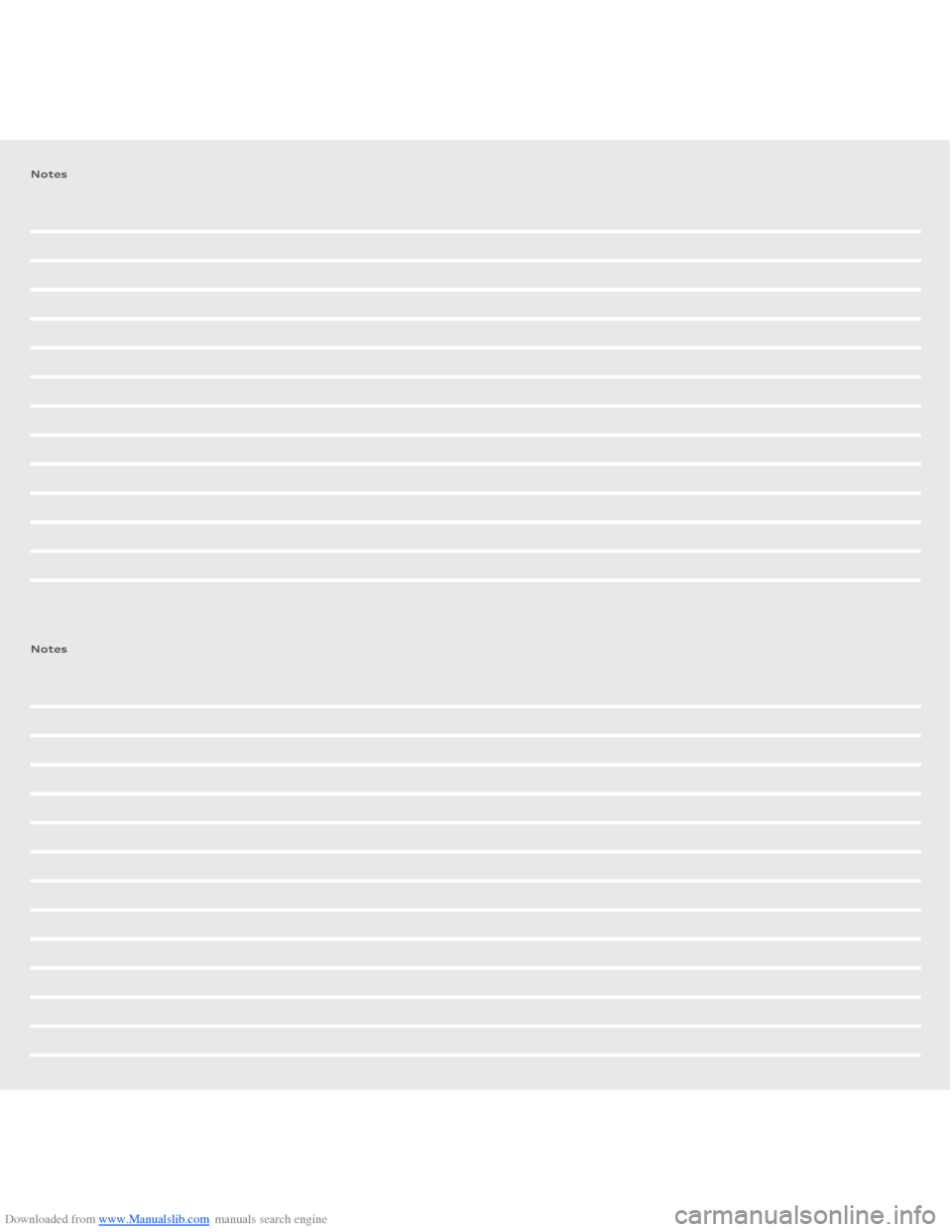
Downloaded from www.Manualslib.com manuals search engine NotesNotes
Page 28 of 29

Downloaded from www.Manualslib.com manuals search engine Notes
Page 29 of 29
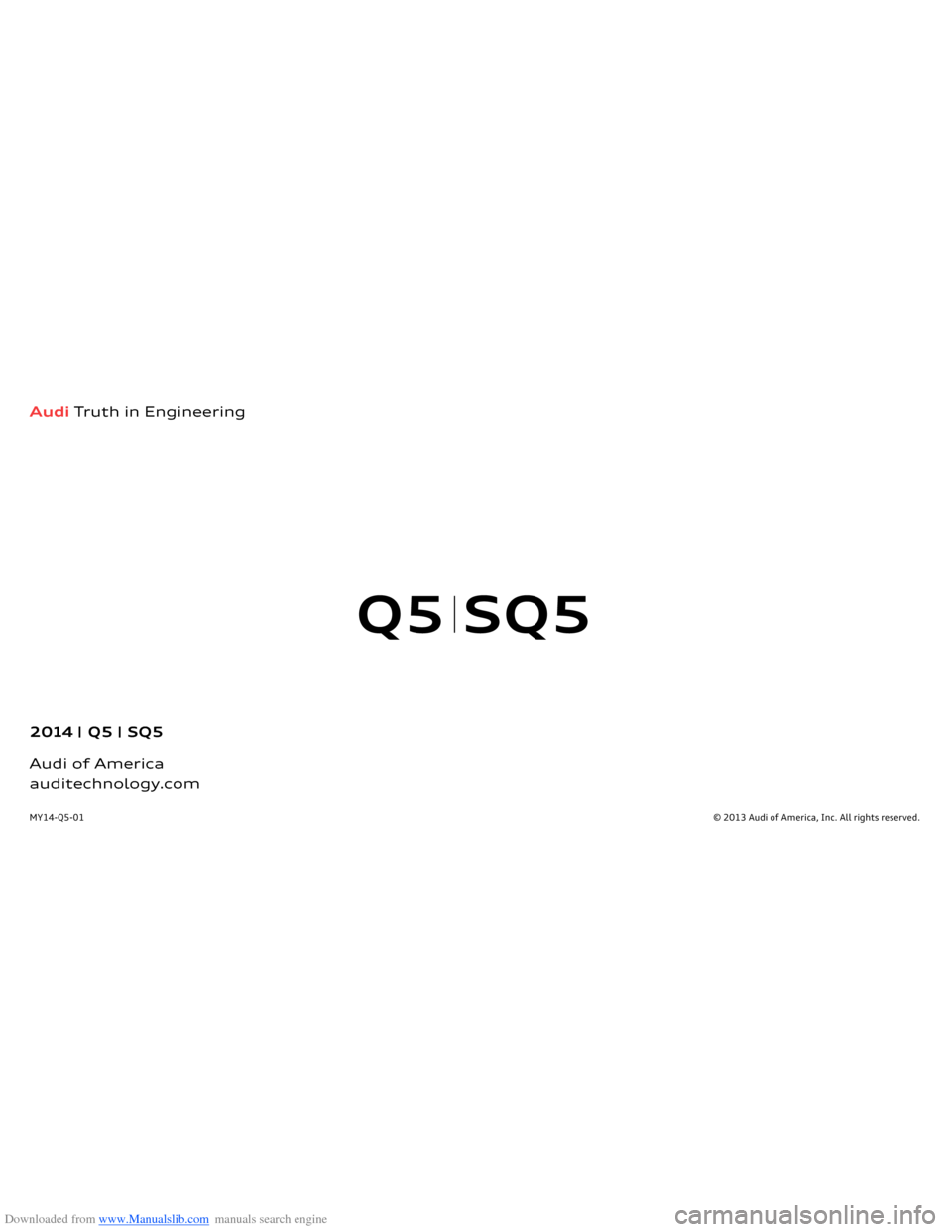
Downloaded from www.Manualslib.com manuals search engine Q5 SQ5
© 2013 Audi of America, Inc. All rights reserved.
Audi
Truth in Engineering
2014 Q5 SQ5
Audi of Americaauditechnology.comMY14-Q5-01
||